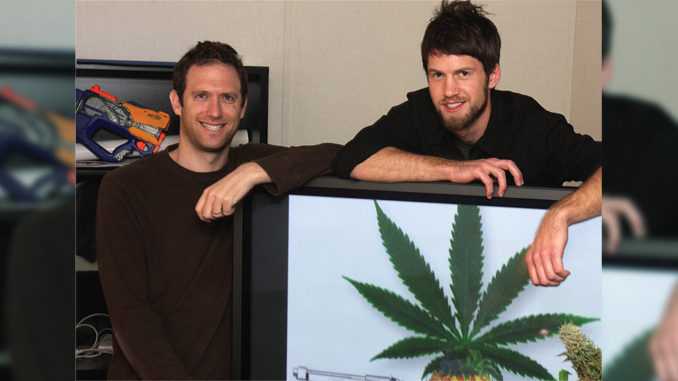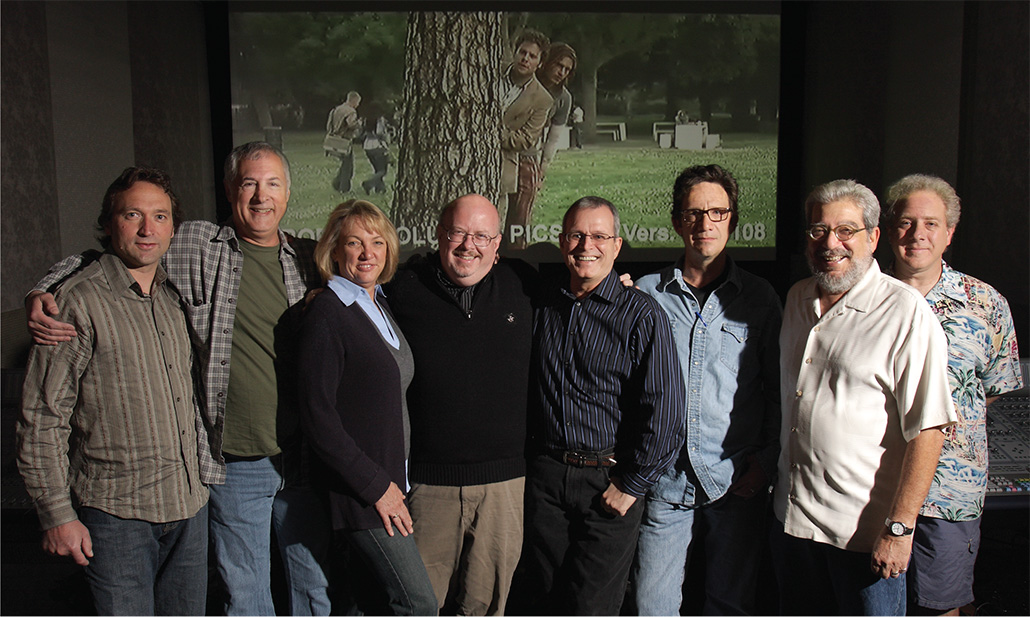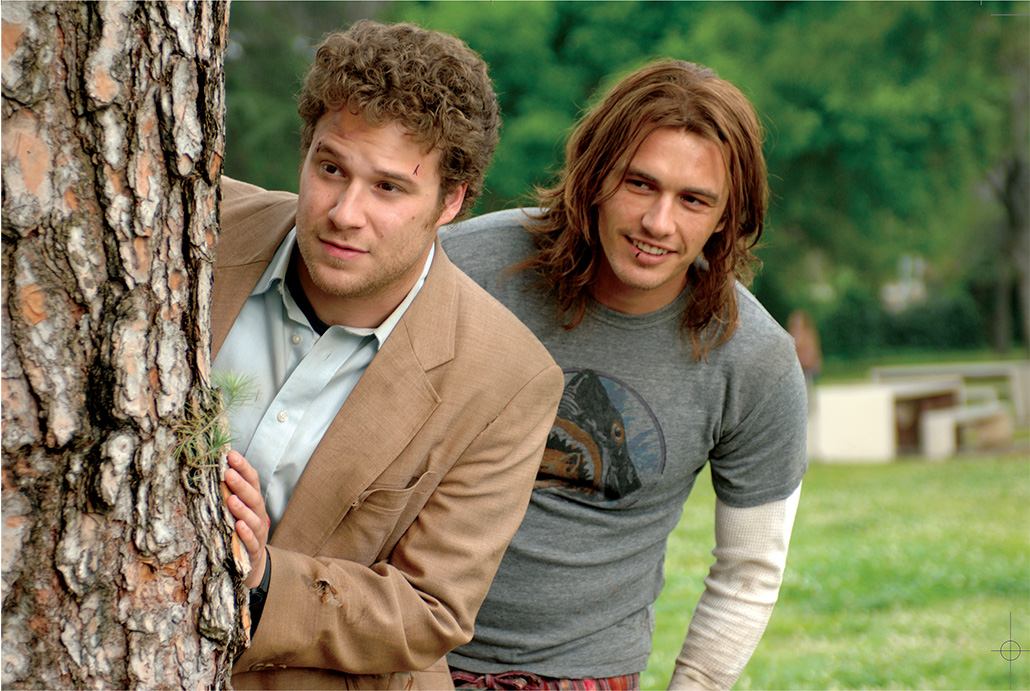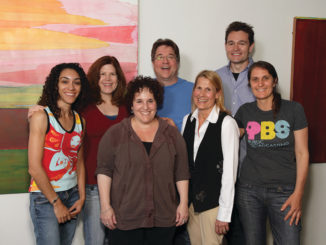
by Michael Kunkes
When re-recording mixer Michael O’Farrell joined the crew of Pineapple Express, he asked supervising sound editor George Anderson what the film was about. Anderson replied, “Well, it’s ‘Cheech and Chong meets Die Hard.’” O’Farrell asked what he meant by that, to which Anderson said simply, “You’ll see.”
Pineapple Express, a Columbia Pictures release, looks to be one of the major “hits” of the 2008 summer season when it opens August 8, especially with the track record of producers Judd Apatow and Shauna Robertson (Superbad, Knocked Up, The 40 Year Old Virgin). It also marks the Hollywood debut of director David Gordon Green, known for underrated, quirky indie movies such as George Washington (2000), All The Real Girls (2003) and last year’s Snow Angels.
Written by Seth Rogen and Evan Goldberg, Pineapple Express is a buddy action comedy about two stoners: harried process server Dale Denton (Rogen), and his way-too-laid-back pot dealer Saul Silver (James Franco), who together run afoul of murder, crooked cops, rival drug gangs and a new, rare and righteous strain of marijuana called “Pineapple Express.”
Though the time is present day, the look and feel of Pineapple Express is pure 1970s action comedy, including the beat-up ‘70s car that Rogen drives, old-style picture wipes, the disco-funk score by Graeme Revell, and even the original end-credit crawl song written and performed by Huey Lewis and the News. “David is a huge fan of ‘70s and ‘80s movies, and he didn’t want this to feel like a normal comedy,” explains picture editor Craig Alpert, who certainly has had his experiences in abnormal comedy after being one of three editors on Borat.
Pineapple Express is Alpert’s fourth film with Apatow. The logical question to ask first is: How, as an editor, do you “cut stoned?” For Alpert, the answer was simply to just let the pot play, as he did in one of his favorite “high points,” of the movie––the lengthy scene early in the film where Rogen’s character goes to buy grass from Franco, and we are introduced to the “Christ Joint”––two joints rolled in the shape of a cross and lit from three ends. It’s a scene that goes on for ten minutes, cutting back and forth between one actor on a couch, the other on a chair across the room. “You have to be careful not to make the characters over-stoned,” says Alpert. “It helps that they are high for the entire movie, so the style really just sort of happens. You let the characters dictate the pace, try to feel what they feel, and let them enjoy what they are doing––without getting stoned yourself, of course.

“Judd’s movies have so much improvisation that I always cut at least two versions of every scene,” Alpert continues. “I try to open as many comedic doors as possible and show the director different ways to shape a scene. David was always open to experimentation with both sound and picture, and he was always ready to take things over the top.” According to Alpert, Green lets the camera roll and encourages improv––and many times the camera will roll out before the actors are finished.
“Judd and David’s styles make it very easy to cut multiple versions of each scene, which are then mixed and matched during the extensive preview process,” Alpert says. Previews, early and often, are a hallmark of an Apatow-produced or -directed movie, and Pineapple Express had seven altogether, some just a week apart.
To help navigate through all the improvised sequences, Alpert extensively used Avid’s Script Tool, an older but still useful utility on a show such as Pineapple. “The assistants import the final draft file of the script and open it within Avid,” he explains. “Dailies are dragged into the script and the assistants place a mark next to the text every time a line is read. From there, they create topics in the script and organize (generally by color-coding) the large amounts of improv dialogue so that I can locate them easily. It’s a lot of work for my assistants, but its a great organizational tool and speeds up the editing process, since it helps me locate both improv subjects and scripted lines.”
Apatow’s Crew Reunites
Pineapple’s picture and sound editorial set up shop at Lantana in Santa Monica; more specifically, most of the editorial crew from the Apatow-directed Knocked Up simply moved on board the new film. Four Avid 11.2.7 Meridiens were in place—one each for Alpert, first assistant Colin Patton, additional editor Tim Mirkovich and a fourth for another assistant, Ray Neapolitan, and apprentice Nathan Bruner, with post PA (now apprentice) Jim Carretta using a software-only Media Composer. More than 800,000 feet of three-perf Super 35mm stock was shot in 2.40:1 anamorphic scope aspect ratio (with some four-perf for action sequences), and stored on a Unity.
“Three-perf saves a lot of money, because you get more frames per foot, but it’s hard to work with because of key code tracking issues with Meridien and Super 35,” says Patton, who began working with Alpert as an apprentice on Borat and has been with him ever since. “Those same issues dictate that we also have to separate the three-perf from the four-perf for the VFX and DI scanning and negative cutting to ensure accurate turnovers.”
Supervising sound editor Anderson is another Apatow devotee and one of the most respected sound professionals in post, with more than 50 major effects and dialogue credits going back to 1981’s Thief. The most critical part of his job, he says, is putting together a great crew, and on Pineapple Express, he assembled a group that included ADR supervisor Larry Kemp, dialogue editors Michael Haight and Jim Matheney, ADR mixer Greg Steele, Foley editor Bruce Lacy, assistant sound editor Bill Burns, music editor/supervisor Jonathan Karp, co-supervising sound editor/effects mixer O’Farrell and sound effects editors Joe Schiff and Cindy Marty.

Marty has been working with Anderson since their days at Stephen J. Cannell Productions in the late 1980s. She has won three Golden Reel Awards––for Titanic (1997), Die Hard (1988) and Predator (1987), and is a member of the Academy of Motion Picture Arts and Sciences’ Sound branch. “George likes to work with a small crew, and we all wear many hats,” she says. “It’s all about getting the job done; sometimes a department will need help and we all pitch in. George hires us, and then gets out of the way. That’s the beauty of working with him. He’ll assign something, and we’ll go after it. He also cuts a lot of his own effects, which is a trend you’re seeing more and more of today.”
The sound team on Pineapple Express was helped by the availability of superior production dialogue, as well as by Anderson’s personal sound effects library, which he and Marty have been building since they started gathering extra prints from sound effects kits 20 years ago. Eventually, all these 35mm and quarter-inch mag rolls went onto DAT, and finally onto a hard drive. “There weren’t too many situations where we had to replace dialogue, so we used ADR mainly to try out or add off-camera jokes; it wasn’t used just as a fix,” Anderson adds. “I’ve always liked saving production sound, especially crowd scenes. I’ve traded around some of my library with other sound editors, and we’ve also done a lot of custom recording over the years.”
Though a cartoony movie, there is a lot of graphic violence in Pineapple Express—shootings, stabbings, a throat slashing and gun battles—and it is played real, at least from a sound editor’s standpoint. Marty, a self-admitted car and explosives sound-effects freak, recalls, “Before we started this show, George and I pulled a whole library of guns, body falls, hits, punches and explosions [including some old effects from Die Hard and Road House, among others]. Violence is real, and we don’t play it any other way.” Marty cites the climactic gun battle between the rival drug gangs, on which Anderson cut the effects. “George did an amazing job,” she says. “It’s almost symphonic due to the dynamics of fire and the unique gun sounds each gang uses; yet it was very clean and left the midrange open for the dialogue.”
“I was totally intent on people knowing who was shooting at whom––even when the shots were off-screen,) Anderson elaborates. “The Asian gang was using Mac-10s, while the rival gang used AK-47s, and we had the identification totally covered. We want our sound effects to play the action as accurately as possible. This film gave us plenty to work with.”

A time-saver on Pineapple was the choice to mix temp effects in the Avid. Anderson and Marty cut a stereo background track, added hard effects on the center channel, provided all the stems and did a pre-mix. Then Alpert did a full three- and sometimes four-channel mix on the Avid. The idea, ultimately, was to get to the final mix with maximum quality and a minimum of tracks. “Craig and David both like to have really great sound from the beginning, with the tracks very filled out,” says Patton. “A lot of editors will just cut to a two-channel stereo mix, but on Pineapple, we had all the Avids equipped with left-center-right channels and great Mackie HR824 speakers. That allowed us to separate the dialogue, music, hard effects and background effects––and we could cut to the same sound we’d be hearing at the previews.”
Alpert adds, “We don’t want to spend four days on a dub stage before every screening. By mixing George’s LCR effects stems into the Avid early on, we knew we’d be able to use that extra time to edit picture right up until the day before a preview. It also helped because we were doing constant turnovers, sometimes in little chunks of reels. It wasn’t a final mix, but would give everyone a pretty good idea of what we would be presenting at the end.”
Anderson also went to previews equipped with a hand-held Sweetwater multi-track Zoom digital recorder and recorded the audiences in real time. The next day, the track was loaded into the Avid, and Alpert and Green reviewed and adjusted the cut in preparation for the next preview. “At the screening itself, you’re so caught up in watching the movie that you don’t always hear and remember the audience laughter,” says Alpert. “So as David and I go through and start to re-edit, we can assess how every joke in a scene played.”
Mixing for Laughs
The final mix was done on Stage 7 at Sony Pictures Studios on two linked Digidesign Icon consoles, with David Giammarco mixing music and dialogue, and O’Farrell mixing sound effects. Giammarco has been mixing since 2003, after a 20-year career as a sound effects and dialogue editor; he earned a Best Sound Oscar nomination last year for 3:10 to Yuma. Pineapple Express is O’Farrell’s third credit as a re-recording mixer; as a supervising sound editor, he has won four Genie Awards and a pair of Directors Guild of Canada Craft Awards.
O’Farrell came aboard Pineapple Express to take over the job of supervising sound editor when Anderson had to move onto Nicholas Stoller’s Forgetting Sarah Marshall, then came over to the final mix. A frequent collaborator of David Cronenberg (as is Giammarco), he came to Pineapple Express just three days after finishing Cronenberg’s Eastern Promises. “For about a week, I was wondering what I was getting into, because on Eastern Promises, we worked hard to make everything incredibly quiet; when things happened, they came out of nowhere,” O’Farrell says. “Pineapple Express was totally the opposite, but that’s what I loved about it.”
Taking over Anderson’s already pre-dubbed effects tracks, O’Farrell and Marty continued the process of feeding material to the picture department. “A lot of my process was about making the sound richer so that we could eventually get it to 5.1 and give it a lot more movement than was in the temp version,” says O’Farrell. “George set it all up, and I just took it to the loudest possible extent!”
Though the time is present day, the look and feel of Pineapple Express is pure 1970s action comedy.
Giammarco spent seven days pre-dubbing dialogue, then went straight into the final mix, at the pace of two days per reel over two weeks. “My main concern in shaping the rapid-fire dialogue was twofold,” he explains. “Seth Rogen’s character has a strong, deep voice, while James Franco’s was softer and more in the mid-range, and it was important to make the dialogue come across clearly and evenly. Secondly, the production dialogue and ADR material had to be as intelligible as possible because the performances were just so good and you didn’t want to lose any laughs.”
O’Farrell and Giammarco’s different working styles meshed well, O’Farrell relates. “Dave is more into film-style mixing, while because I am still steeped in DAW mixing, my attitude is more keyboard-based––and he is more fader-oriented,” he offers. “But each of us always know what the other is doing.”
For the final, Giammarco worked with a ten-channel dialogue pre-dub, 17 channels of ADR and group pre-dubs, and another 57 channels of music mix-downs. “My big concern was to try to serve the music as best I could,” he says. “I was able to do this thanks to the flexibility of the music stems that Graeme Revell and Jonathan Karp provided. For our final setup, Mike had his effects system with Foley, sound effects and backgrounds, while I incorporated the music elements into the dialogue session of the Icon.”
“During the fix passes at the final, I could go my own way on headphones, while Dave was mixing dialogue and music on the big speakers,” O’Farrell adds. “It gave us a lot of flexibility because I was recording to my own ProTools system while he worked more in the Icon’s virtual environment; we could leapfrog each other to keep a good workflow going.”
O’Farrell praised the work of Anderson and the sound effects team, especially in the movie’s two slapstick action sequences: an extended and comically violent three-way fight scene between Rogen, Franco and Danny McBride (who in the course of the scene is punched, kicked, stabbed and shot repeatedly, but just won’t go down), and a long car chase through the LA streets. “There was a lot great bong work on those tracks,” he jokes. “Actually, there was never any actual sitting around and getting stoned––but the whole attitude of Pineapple Express kind of sinks into you anyway.”






